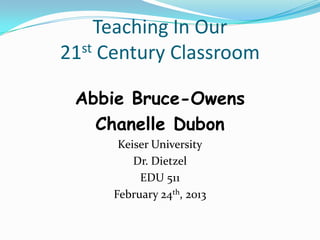
Jing in the 21st Century Classroom
- 1. Teaching In Our 21 st Century Classroom Abbie Bruce-Owens Chanelle Dubon Keiser University Dr. Dietzel EDU 511 February 24th, 2013
- 3. A Quick Look At Our Teachers In Earlier Years
- 4. A Quick Look At The Diverse Population of Teachers In Our Classrooms Today
- 5. A Quick Look At The Technology Used In Our Classroom In Earlier Years
- 6. A Quick Look At The Technology Used In Our Classroom Today
- 7. How Has the Classroom Changed? Several aspects of our classroom seem to have changed when compared to that of the traditional classroom setting several years ago. In addition to the shift from the all-Caucasian educator to a more diverse set of educators, so too are our methods of teaching in the classroom changing. We have now moved to a shift where Web 2.0 Tools have been introduced into the classroom to enhance teaching thereby making the learning experience fun and engaging(Brinkerhoff & Koroghlanian, 2007).
- 8. Some Examples of Web 2.0 Tools? Some examples of Web 2.0 Tools are: Social Networking: Twitter, Facebook, LinkedIn YouTube Wiki Jing Blogs LinkedIn Video Sharing Avatars
- 9. Some Familiar Web 2.0 Logos
- 10. All About Jing….. Jing is changing the way we communicate by providing a more personal way for educators to give their students feedback. It is also changing the way that students work assignments in their courses. Students can summarize articles in a Jing clip instead of creating a response in a word document, allowing students to really absorb what they are learning in the classroom (Bianco & McCollom, 2011).
- 11. Ancient –vs- Modern Schools have shifted toward computer based learning in order to keep abreast with the on-going changes outside of the classroom. The use of computers in the home and workplace are no longer a thing of the past, therefore educators need to be able to keep their students motivated and challenged through innovative teaching methods (Jenkins, 2006).
- 12. Ancient -vs- Modern (Cont’d) In today’s society where many resources are available at the click of a mouse, students have access resources that were not available in the past and require stimulation to stay engaged as active learners in the classroom (Collins, 2013).
- 13. What is expected of Educators? To highlight the positive aspects of using technology in the classroom - the advantages of using technology. Educators are expected to become familiar with Web 2.0 technology and to know which can be used in his/her classroom in order to enhance and ensure learning. Through the use of Jing and other Web 2.0 technology tools, educators are expected to bridge the gap between the traditional methods that were used in the classroom and replace them with the 21st century teaching technology tools (Jing, 2009).
- 14. Benefits of Embracing Jing In The Classroom Advantages Some advantages of using Jing technology tool is that the technology is simple to use and can be used the through screenshots or through recorded videos. It encourages extensive teamwork, partnership, and collaboration. It is a wonderful tool for individuals with visual impairments. As a asynchronous learning tool it is accessible to students and teachers at any time. The recorded videos are great for those students who are auditory learners and can be replayed when needed. Students will respond more eagerly when they are able to relate to experiences connected to their own lives. Web 2.0 technology provide the opportunities necessary to encourage collaboration and learning (Gonzalez & St. Louis, 2008).
- 15. When Jing is NOT Embraced In The Classroom Disadvantages Some critics complain that the publicity with Web 2.0 technology tools are too much. Students who are visual and tactile learners may not be able to reach their goal for lack of focus, engagement and fun in learning (Tunks, 2012).
- 16. Summary The modern-day classroom setting houses students familiar with the use of Web 2.0 technology tools , who are becoming even more proficient other varieties of this technology. Student are afforded the flexibility to collaborate and communicate knowledge to peers as they enjoy learning and sharing knowledge learned.
- 17. References: Bianco, M. & McCollom, D. (2011). Chapter 9 jazzed about jing. University of Colorado Online Handbook, 59-65. Brinkerhoff, J. & Koroghlanian, C. (2007). On-line students' skills, attitudes and expectations: Enhancing the fit between on-line students and course design. Journal of Educational Computing Research, 36(4), 383-393. Collins, A. (2013). The role of computer technology in restructuring schools. Project 2061. Retrieved from http://www.project2061.org/publications/designs/online/pdfs/reprints/4_collin.pdf Gonzalez, D. & St. Louis, R. (2008). The use of web 2.0 tools to promote learner autonomy. Independence, 43(1), 28-32. Jenkins, H. (2006). Convergence culture: Where old and new media collide. New York, NY: University Press. Jing, L. (2009). Digital natives as preservice teachers: What technology preparation is needed? Journal of Computing in Teacher Education, 25(3), 87-97. Tunks, K. W. (2012). An Introduction and Guide to Enhancing Online Instruction with Web 2.0 Tools. Journal Of Educators Online, 9(2), 1-16.